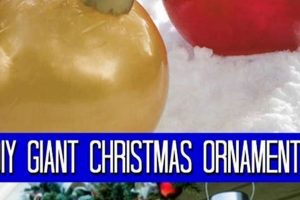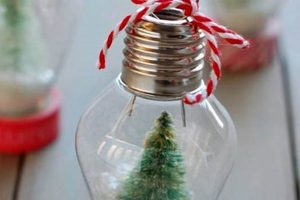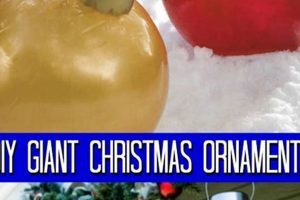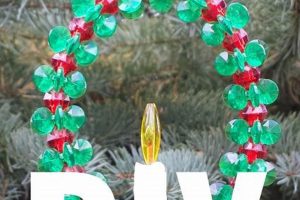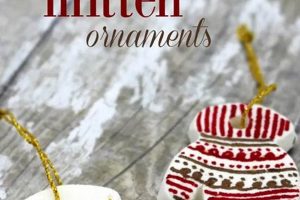The construction of miniature winter scenes encased within transparent spheres, designed for seasonal tree decoration, is a craft activity involving readily available materials. These self-made decorations often feature figurines, glitter, and distilled water, providing a personalized alternative to commercially produced ornaments. For instance, a small plastic animal secured within a glass ball filled with shimmering flakes transforms into a unique holiday adornment.
Creating customized holiday decorations offers several advantages, including cost-effectiveness and creative expression. The activity fosters resourcefulness by repurposing household items and provides an opportunity for personalized gifting. Historically, the creation of ornaments has been a cherished tradition, connecting individuals to past generations and fostering a sense of communal celebration. This specific craft allows for the continuation of this tradition in a modern, adaptable manner.
The following discussion will delve into specific techniques for crafting these unique decorations, exploring various material options, and offering guidance on achieving durable and aesthetically pleasing results. Detailed instructions on sealing mechanisms and design considerations will also be presented.
Crafting Durable and Appealing Miniature Winter Scenes
Creating enduring and visually pleasing miniature winter scenes requires careful consideration of materials, assembly techniques, and sealing procedures. The following recommendations aim to enhance the longevity and aesthetic quality of these handcrafted decorations.
Tip 1: Select Appropriate Adhesives: Utilize waterproof and non-yellowing adhesives to secure internal components. Epoxy resins or specialized craft glues designed for bonding dissimilar materials are recommended for ensuring a robust and enduring bond, preventing detachment and clouding over time.
Tip 2: Distilled Water is Critical: Employ only distilled water as the suspending medium. Tap water contains minerals and microorganisms that can cause clouding, discoloration, or even algae growth, compromising the clarity and visual appeal of the finished product.
Tip 3: Pre-Test Materials: Before final assembly, submerge all internal components in distilled water for several hours. This pre-testing identifies materials that may leach color, degrade, or react adversely with the water, preventing unwanted surprises after sealing.
Tip 4: Secure Sealing Techniques: Implement a robust sealing method to prevent leaks. Employing a rubber gasket or multiple layers of waterproof sealant around the closure point is crucial for maintaining water tightness and preventing evaporation or spillage.
Tip 5: Glitter Selection Matters: Opt for fine, non-bleeding glitter specifically designed for use in water. Craft glitters that are not colorfast can leach dye, discoloring the water and diminishing the aesthetic quality of the ornament.
Tip 6: Consider Ornament Weight: Select lightweight materials for internal components to minimize stress on the sealing point and the tree branch upon which the ornament is hung. Excessive weight can lead to seal failure or damage to the tree.
Tip 7: Design for Visual Balance: Arrange the internal components in a visually balanced and aesthetically pleasing manner. Consider the scale and placement of figurines, glitter distribution, and overall composition to create a harmonious and engaging winter scene.
Adhering to these guidelines contributes to the creation of miniature winter scenes that are both visually appealing and structurally sound, ensuring years of enjoyment. Prior planning and meticulous execution are key to achieving professional-looking results.
The following section will explore creative variations and advanced techniques, expanding upon the fundamental principles outlined above.
1. Materials Selection
Material selection represents a cornerstone in the successful execution of encased miniature winter scenes, directly influencing the aesthetic appeal, durability, and overall longevity of the finished product. Thoughtful consideration of material properties is paramount to avoid degradation, discoloration, or structural failure over time.
- Figurine Composition
The material composing the central figurine or decorative elements determines its resistance to water damage and potential leaching of chemicals. Polymer clay, known for its water resistance and colorfastness, is a suitable choice. Conversely, porous materials like untreated wood or certain paints may absorb water, leading to swelling, cracking, or the release of dyes that cloud the liquid medium. The selection of appropriate figurine composition contributes significantly to the long-term visual clarity and integrity of the ornament.
- Glitter Type
The type of glitter employed plays a crucial role in maintaining the water’s clarity and overall visual appeal. Craft glitter, commonly available, may leach color or degrade in water, leading to discoloration and a diminished aesthetic effect. Opting for glitter specifically designed for use in water, typically composed of non-bleeding materials like PET (Polyethylene Terephthalate), ensures the water remains clear and the glitter retains its brilliance over time. Selecting appropriate glitter prevents the unintended degradation of the ornament’s visual quality.
- Globe Composition
The material comprising the enclosing sphere influences its clarity, durability, and potential for leakage. Glass offers superior clarity and resistance to scratching compared to plastic, enhancing the visual presentation of the miniature scene. However, glass is more susceptible to breakage, requiring careful handling. The selection of the globe material balances the desire for optimal visual clarity with practical considerations of durability and safety. The chosen globe impacts the perceived quality and longevity of the decoration.
- Adhesive Properties
The adhesive used for bonding components within the enclosed sphere requires specific properties to ensure a durable, watertight seal. Cyanoacrylate adhesives (super glue) are commonly employed for their quick-setting nature and strong bonding capabilities. However, it is essential to select a grade that is waterproof and non-yellowing to prevent degradation and discoloration over time. The choice of adhesive directly impacts the ornament’s structural integrity and its ability to maintain a leak-proof enclosure. Selecting an inappropriate adhesive can lead to water ingress and subsequent damage to the internal components.
These material choices, taken together, exemplify the critical role material selection plays in the creation of enduring and visually appealing encased miniature winter scenes. Careful consideration of these aspects ensures that the finished product remains a cherished holiday decoration for years to come. Overlooking these material considerations can result in decorations that quickly degrade and lose their aesthetic appeal.
2. Adhesive Integrity
Adhesive integrity is paramount to the durability and longevity of enclosed miniature winter scene ornaments. The selection and application of appropriate adhesives directly influence the ornament’s ability to withstand environmental stressors and maintain its structural integrity over time.
- Waterproof Properties
The adhesive must possess inherent waterproof characteristics to prevent water ingress into the sealed environment. Water infiltration can lead to clouding of the liquid medium, corrosion of metallic elements, and degradation of organic materials within the ornament. Examples of suitable adhesives include epoxy resins and certain cyanoacrylate formulations specifically designed for underwater applications. Failure to utilize a waterproof adhesive inevitably results in premature deterioration of the ornament’s visual appeal and structural soundness.
- Chemical Inertness
The adhesive should exhibit chemical inertness to prevent reactions with the liquid medium, figurines, or glitter particles contained within the ornament. Certain adhesives may leach chemicals that cause discoloration, clouding, or degradation of the internal components. Silicone-based adhesives are often favored for their chemical inertness and resistance to degradation in aqueous environments. Selecting a chemically inert adhesive mitigates the risk of undesirable chemical interactions that compromise the ornament’s aesthetic quality and longevity.
- Bond Strength and Durability
The adhesive must provide sufficient bond strength to securely attach the base to the globe, resisting separation under stress. Temperature fluctuations, handling, and the weight of the internal components exert constant stress on the adhesive bond. Structural adhesives, such as two-part epoxies, are often preferred for their high bond strength and resistance to shear forces. Ensuring adequate bond strength is crucial for preventing leaks and maintaining the structural integrity of the ornament over its lifespan.
- UV Resistance
Prolonged exposure to ultraviolet (UV) radiation can degrade certain adhesives, leading to embrittlement, cracking, and eventual bond failure. If the ornament is expected to be displayed in areas with significant UV exposure, selecting a UV-resistant adhesive is essential. UV-resistant formulations often incorporate additives that absorb or reflect UV radiation, protecting the adhesive from degradation. The selection of a UV-resistant adhesive prolongs the ornaments lifespan and prevents premature bond failure due to environmental exposure.
These factors demonstrate the critical role adhesive integrity plays in the creation of enduring and visually appealing enclosed miniature winter scenes. Selection of an inappropriate adhesive compromises the ornament’s longevity and aesthetic quality, ultimately diminishing its value and appeal. Careful consideration of these aspects ensures that the finished product remains a cherished holiday decoration for years to come.
3. Water Clarity
Water clarity is a critical determinant of the aesthetic success of encased miniature winter scenes. The visual appeal of these ornaments hinges on the unobstructed view of the miniature landscape and simulated snowfall within. Any reduction in water clarity diminishes the observer’s ability to appreciate the intricate details and dynamic elements of the contained scene. The causative factors affecting water clarity include impurities within the water itself, leaching from internal components, and microbial growth. The use of non-distilled water, for example, introduces minerals and organic matter that can cloud the liquid over time. Similarly, certain paints or adhesives may release substances into the water, causing discoloration or turbidity. A practical example is the use of tap water versus distilled water, demonstrating that tap water leads to clouding over time, while distilled water typically maintains clarity for extended periods. The initial selection of pure materials and meticulous assembly techniques directly influence the long-term maintenance of optimal water clarity, a key component of successful snow globe ornament construction.
Maintaining optimal water clarity is further complicated by the potential for microbial growth within the sealed environment. Even minute quantities of organic contaminants can provide a substrate for bacteria or algae, leading to visible clouding or discoloration. The exclusion of air from the sealed environment does not necessarily eliminate the risk of microbial proliferation, as some microorganisms can thrive in anaerobic conditions. The practical application of this understanding dictates that all components, including the water and internal elements, must be thoroughly sterilized prior to assembly. Furthermore, the addition of a small quantity of algaecide or biocide may be necessary to inhibit microbial growth over the long term. This is exemplified by commercially produced snow globes, which often incorporate such additives to ensure prolonged water clarity and prevent unsightly biological contamination. The long-term visual impact and perceived quality are intrinsically linked to water clarity, demanding careful attention to sterilization and prevention of microbial growth.
In summary, water clarity is not merely an aesthetic concern, but a functional prerequisite for the successful design and construction of enclosed miniature winter scenes. Achieving and maintaining optimal clarity necessitates a multifaceted approach, encompassing the selection of purified water, the use of inert and non-leaching materials, rigorous sterilization procedures, and the potential incorporation of antimicrobial agents. Challenges arise from the inherent complexities of sealing a closed system and the potential for unforeseen interactions between components over time. Addressing these challenges directly translates to ornaments of enhanced visual appeal, durability, and long-term value, directly contributing to the continued appreciation of these crafted decorations.
4. Sealing Methods
The preservation of the enclosed environment within a miniature winter scene ornament hinges critically on the efficacy of the chosen sealing method. This process, vital to preventing leakage and maintaining aesthetic integrity, demands careful consideration of materials, techniques, and environmental factors.
- Adhesive Application Techniques
The manner in which adhesive is applied significantly impacts the integrity of the seal. Uniform application, free from air bubbles or gaps, is essential. Over-application may result in unsightly overflow or incomplete curing, while under-application compromises the bond strength. Precision application tools, such as syringes or fine-tipped applicators, enable controlled distribution. For example, applying epoxy resin in thin, even layers maximizes surface contact and minimizes the risk of trapped air, ensuring a robust and leak-proof seal.
- Gasket Utilization
Incorporating a gasket, typically made of rubber or silicone, provides an additional layer of protection against leakage. The gasket acts as a compressible barrier, conforming to irregularities between the globe and base. Proper gasket selection, based on material compatibility and dimensional accuracy, is crucial. An improperly sized or incompatible gasket may deform under pressure, compromising its sealing capability. For instance, a silicone gasket effectively seals glass-to-plastic interfaces due to its flexibility and resistance to degradation.
- Threaded Closure Systems
Threaded closures, involving the mechanical engagement of matching threads on the globe and base, offer a secure and repeatable sealing mechanism. The torque applied during closure determines the compressive force on the sealing surfaces. Over-tightening can damage the threads or the globe itself, while under-tightening may result in leakage. Calibrated torque wrenches ensure consistent and appropriate closure force. An example of this is seen in ornaments using a screw-on base, where precise torque application guarantees a reliable seal.
- Curing and Drying Procedures
Adhesive-based sealing methods require adequate curing or drying time to achieve optimal bond strength and water resistance. Premature handling or exposure to water can disrupt the curing process, weakening the seal. Following the manufacturer’s recommendations for curing time and temperature is crucial. Employing a controlled environment, such as a drying oven, can accelerate the curing process and improve bond strength. An example is allowing epoxy resin to cure fully for 24 hours at room temperature, ensuring maximum adhesion and water resistance.
In conclusion, the selection and meticulous execution of appropriate sealing methods are foundational to the successful creation of long-lasting and aesthetically pleasing miniature winter scene ornaments. Improper sealing techniques inevitably lead to leakage, compromising the integrity and visual appeal of the finished product. The integration of these techniques ensures a robust and enduring seal, preserving the enclosed environment for years to come.
5. Design Principles
The application of fundamental design principles is critical to the successful creation of aesthetically pleasing and structurally sound miniature winter scene ornaments. These principles govern the arrangement of elements, the use of color, and the overall visual impact of the finished product.
- Scale and Proportion
The relative size of elements within the ornament dictates its visual harmony. Disproportionate elements, such as an oversized figurine within a small globe, create a sense of imbalance and visual discord. Conversely, appropriately scaled elements contribute to a sense of realism and aesthetic coherence. For example, a miniature village scene requires appropriately sized figures, buildings, and trees to maintain visual fidelity and credibility. Careful consideration of scale and proportion enhances the ornament’s overall visual appeal.
- Balance and Symmetry
The distribution of visual weight within the ornament influences its perceived stability and aesthetic equilibrium. Symmetrical arrangements, where elements are mirrored around a central axis, convey a sense of formality and order. Asymmetrical arrangements, where elements are distributed unevenly, create a sense of dynamism and visual interest. The deliberate use of either symmetrical or asymmetrical balance contributes to the ornament’s overall design. For instance, a balanced composition prevents the ornament from appearing lopsided or unstable when viewed from different angles.
- Color Harmony and Contrast
The selection and arrangement of colors contribute significantly to the ornament’s visual impact. Harmonious color schemes, utilizing related hues and tones, create a sense of unity and coherence. Contrasting color schemes, employing complementary or opposing colors, generate visual interest and emphasis. The judicious use of color harmony and contrast enhances the ornament’s visual appeal. For example, a winter scene might employ a harmonious palette of blues, whites, and silvers, accented by a contrasting pop of red on a miniature cardinal.
- Emphasis and Focus
Establishing a clear focal point directs the viewer’s attention and enhances the ornament’s narrative impact. The focal point may be achieved through the strategic placement of a prominent element, the use of contrasting colors, or the manipulation of light and shadow. A well-defined focal point enhances the ornament’s visual storytelling. For instance, a brightly lit Christmas tree positioned centrally within the scene draws the viewer’s eye and establishes the primary subject of the ornament.
These design principles, when thoughtfully applied, elevate the quality and visual appeal of miniature winter scene ornaments. Attention to scale, balance, color, and emphasis transforms a simple craft project into a visually engaging and aesthetically pleasing work. The success of this craft endeavors relies on the effective incorporation of these design principles.
6. Scale Appropriateness
Scale appropriateness constitutes a critical design parameter in the fabrication of miniature winter scene ornaments. The harmonious integration of disparate elements within the confined space of a spherical enclosure mandates careful consideration of relative sizes to achieve visual coherence and prevent functional limitations.
- Figurine-to-Globe Ratio
The ratio between the dimensions of the figurines and the internal volume of the globe directly affects the visual impact of the ornament. Overly large figurines obstruct the simulated snowfall effect and diminish the sense of depth within the scene. Conversely, excessively small figurines become visually insignificant and fail to engage the viewer. Commercial examples demonstrate a preference for figurines that occupy approximately one-third to one-half of the globe’s vertical height, ensuring prominence without overwhelming the available space. Deviations from this guideline frequently result in visually unbalanced or underwhelming compositions.
- Base Size Relative to Globe
The size of the base must be proportionate to the globe to ensure stability and aesthetic balance. An undersized base compromises the ornament’s ability to stand upright, while an oversized base detracts from the visual focus on the enclosed scene. The diameter of the base should ideally be equal to or slightly larger than the widest diameter of the globe. This dimensional relationship provides adequate support and reinforces the visual hierarchy, emphasizing the enclosed miniature world. Disproportionate bases compromise both the functionality and aesthetic appeal of the finished product.
- Detailing Density and Scale
The level of detail incorporated into individual elements must align with the overall scale of the ornament. Overly intricate detailing on small figurines becomes imperceptible, while insufficiently detailed elements appear simplistic and out of place within a complex scene. For instance, a miniature building intended for a small ornament requires simplified architectural features to maintain clarity and visual coherence. The level of detail should be carefully calibrated to the viewing distance and the scale of the other components, ensuring a harmonious and visually engaging composition.
- Snowflake Size and Density
The size and density of the simulated snowflakes directly influence the perceived realism of the miniature winter scene. Overly large or densely packed snowflakes obscure the figurines and diminish the sense of depth. Conversely, sparsely distributed or excessively small snowflakes fail to create a convincing snowfall effect. The optimal snowflake size and density depend on the overall scale of the ornament and the desired level of visual realism. Commercial snow globes typically employ finely ground glitter or specialized synthetic flakes to achieve a balanced and visually appealing snowfall effect.
In summation, appropriate scale considerations are integral to the successful design and construction of miniature winter scene ornaments. The judicious selection and arrangement of elements, calibrated to the physical dimensions of the globe and base, contribute significantly to the aesthetic appeal, functional stability, and overall visual impact of these handcrafted decorations. Failure to adhere to these principles invariably results in ornaments that are visually unbalanced, structurally unsound, or aesthetically underwhelming, thereby diminishing their intrinsic value and appeal.
Frequently Asked Questions
The following addresses common inquiries regarding the creation of enclosed miniature winter scene ornaments. These questions aim to clarify technical aspects and address potential challenges encountered during the construction process.
Question 1: What type of adhesive is most suitable for sealing the globe to the base?
Epoxy resins or cyanoacrylate adhesives specifically formulated for waterproof applications are recommended. The selected adhesive should exhibit strong bonding capabilities, chemical inertness to prevent reactions with the enclosed medium, and resistance to yellowing over time.
Question 2: Is distilled water truly necessary, or can tap water be substituted?
Distilled water is strongly advised. Tap water contains minerals and microorganisms that can lead to clouding, discoloration, or even the growth of algae, compromising the ornament’s visual clarity. Distilled water minimizes these risks.
Question 3: How can leaks be effectively prevented?
Employing a combination of strategies is optimal. This includes ensuring a clean and smooth sealing surface, using a waterproof adhesive applied uniformly, and considering the inclusion of a rubber or silicone gasket to create a compressive seal.
Question 4: What types of materials should be avoided for the internal components?
Porous materials, such as untreated wood or certain types of fabric, should be avoided as they can absorb water and potentially leach dyes or other substances, clouding the water or causing discoloration. Materials prone to corrosion are also unsuitable.
Question 5: How can one ensure that the glitter remains suspended in the water and does not settle at the bottom?
The density of the glitter influences its suspension characteristics. Employing fine, lightweight glitter specifically designed for use in water is recommended. The addition of a small amount of glycerin or mineral oil can also increase the viscosity of the liquid and promote better suspension.
Question 6: Is there a method to prevent the formation of air bubbles within the ornament?
Careful attention to filling techniques is paramount. Slowly introduce the water, tilting the globe to allow air to escape. After sealing, gently tapping the ornament can dislodge any remaining trapped air bubbles. Air bubble formation is minimized by meticulous assembly.
In summary, achieving a successful miniature winter scene ornament requires careful attention to material selection, sealing techniques, and preventative measures against common issues. The insights provided address frequently encountered challenges and offer guidance for achieving optimal results.
The following section will provide supplementary resources, including recommended materials and step-by-step assembly guides.
Conclusion
The preceding analysis has explored the complexities inherent in “snow globe ornaments diy”. Critical aspects include materials selection, adhesive integrity, water clarity, appropriate sealing methods, and fundamental design principles. Adherence to these guidelines is essential for achieving durable and aesthetically pleasing results. Deviation from established best practices inevitably leads to diminished product quality and longevity.
Mastery of the principles outlined herein allows for the creation of personalized, visually compelling holiday decorations. The ongoing refinement of techniques and exploration of novel materials will undoubtedly further enhance the potential of this craft. Continued investigation into sealing technologies and methods of preserving water clarity are particularly warranted to advance the field and ensure enduring product quality.


